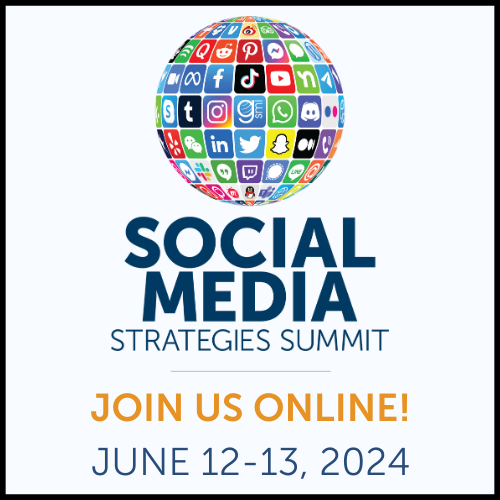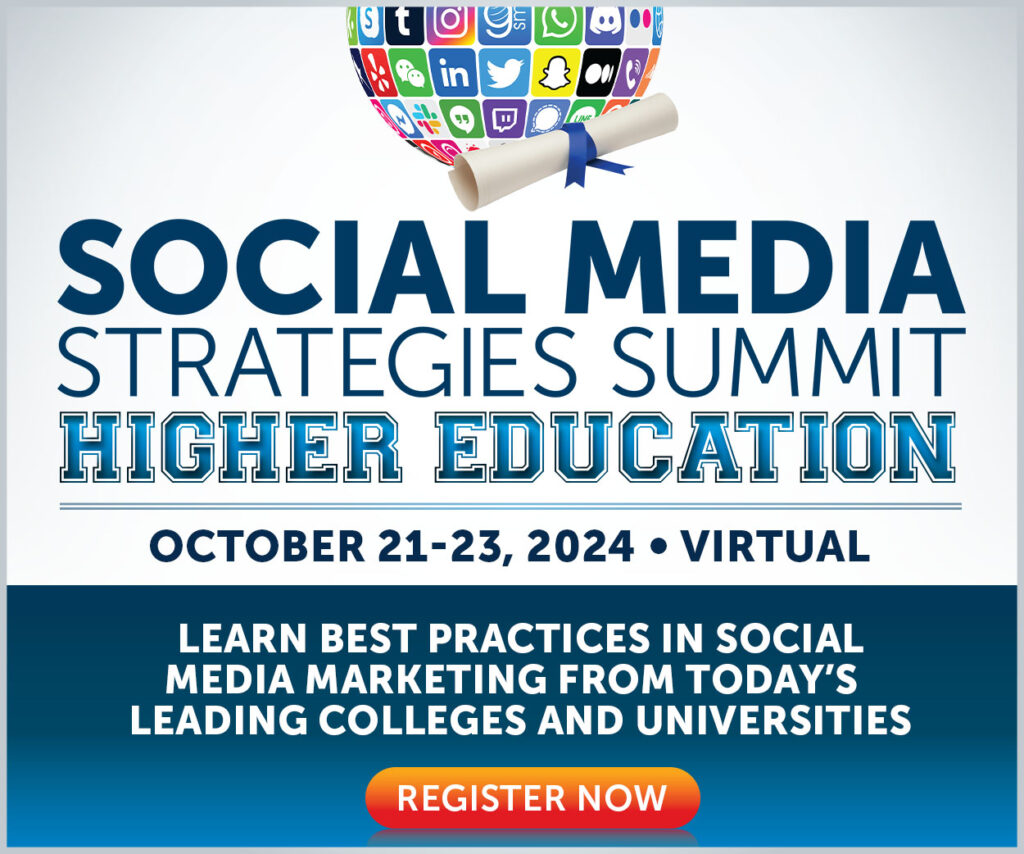As a higher education marketer, you’ve probably heard about the so-called “enrollment cliff” and its potential impact on the higher ed landscape.
But what can you actually do about that?
One of the best people to answer this is Dr. Carrie Phillips, the Chief Communications and Marketing Officer of the University of Arkansas at Little Rock.
For her dissertation, Dr. Phillips researched marketing strategies that universities can use to mitigate the looming cliff. She shared her findings with an audience at our 2023 Social Media Strategies Summit Higher Education Virtual Conference.
Let’s dive into her key learnings and takeaways.
What Is the Enrollment Cliff?
First off, let’s clarify what we’re talking about.
The Western Interstate Commission on Higher Education warned about a forthcoming enrollment cliff, predicting that the number of students graduating from higher education would drop by 350,000 – 400,000 annually.
To understand why, you must rewind the 2007 – 2008 financial crisis.
The economy tanked, and people who might have thought about having kids decided to put it off for a couple of years. Some agreed that bringing a child into the world wasn’t such a good idea.
The US birth rate still hasn’t recovered, which has inevitably brought us to the enrollment cliff we face today. 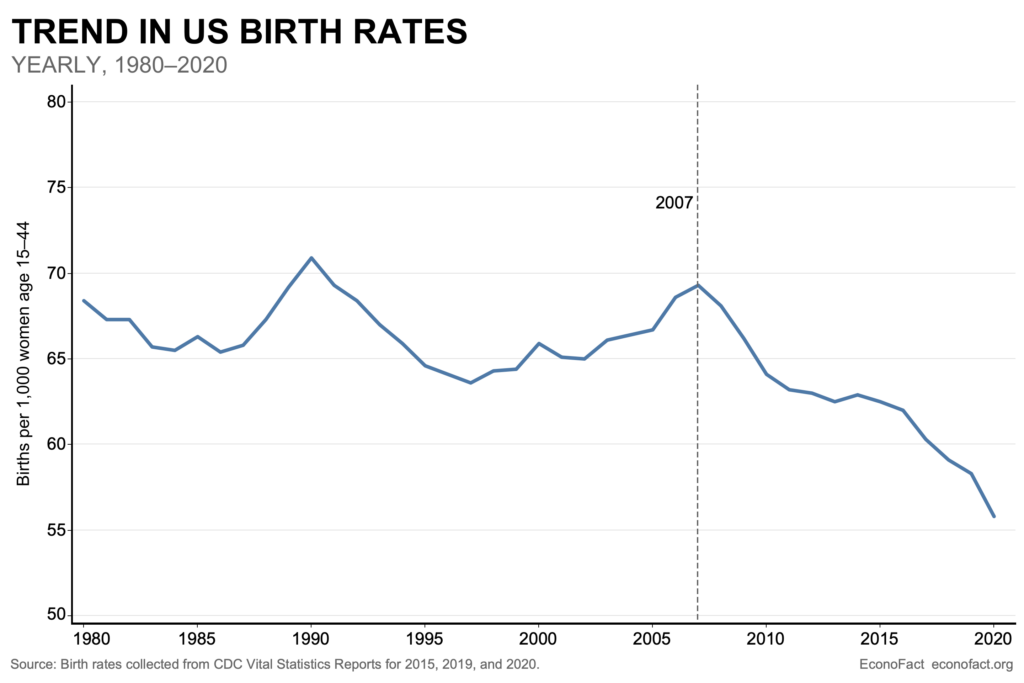
What’s the Impact of the Enrollment Cliff?
A potential 400,000 fewer students sounds scary. However, Dr. Phillips wanted to dig deeper into what that number actually means for higher education institutions.
To do that, she made two assumptions:
- The number of students will remain constant, so there won’t be a sudden influx or decline in high school graduates. “It’s a pretty safe assumption,” says Dr. Phillips.
- The average cost of college tuition is going to stay the same. “That’s a little bit less of a safe assumption,” she notes. “But I think it works for this purpose.”
She predicts that the enrollment cliff will have an impact in three main ways:
1. Demographic Changes
“It’s not just that we’re going to have fewer students,” Dr. Phillips explains. “We’re going to see the demography of the students that are still graduating change.”
Take a look at how student numbers are expected to rise or fall across different demographic groups:
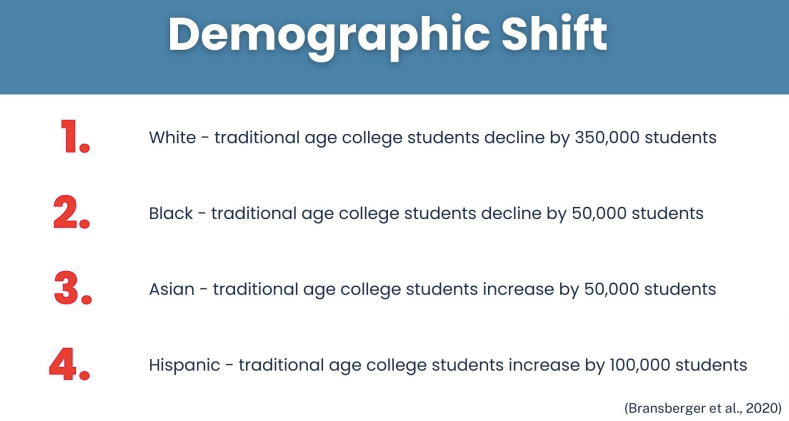
In other words, the enrollment cliff will lead to a very different student body than the one we’re used to today.
2. Financial Impact
Perhaps the biggest impact of the enrollment cliff will be financial.
Based on the average cost of public education tuition and the headline figure of up to 400,000 fewer students, Dr. Phillips says the impact on the higher education industry will be $4.2 billion.
But that’s only scratching the surface because she also expects it to cost more to graduate these students.
First, we need to consider cultural factors.
“For those groups of students that are going to be increasing, chances are their culture has a very strong family focus. They have a culture that may look very different from what our campuses, and the communities where our campuses are located, look like,” Dr. Phillips explains.
“They may have family members who don’t speak the language that is prominent on our campus. And they may have experiences where they haven’t felt welcomed or felt part of a community.”
Adjustments to help them feel like part of the campus and community will require financial investment.
What’s more, Dr. Phillips says those “new” students are more likely to be first-generation college students. First-generation college students are about a third less likely to graduate if they don’t have access to things like:
- Academic support
- Wraparound services
- Tutoring
- Advising
All of which cost money.
“So I would argue that the enrollment cliff cost of $4.2 billion is actually going to be a bit higher,” Dr. Phillips states.
3. Geographic Impact
Every part of the US will experience a decline in student numbers.

However, within each region, there will still be places that see an increase in enrollments. So, does that mean those areas are immune to the enrollment cliff?
Unfortunately not.
“Those places where there is a significant decline are going to start going to those states where there are increases to recruit students there,” Dr. Phillips predicts. “Contiguous states, neighboring states, states in the region are going to start looking to those states to try to grow their own numbers. That is really scary.”
So it’s no surprise to see forecasts that as many as 14% of small institutions could be forced to close, like Cardinal Stritch University.
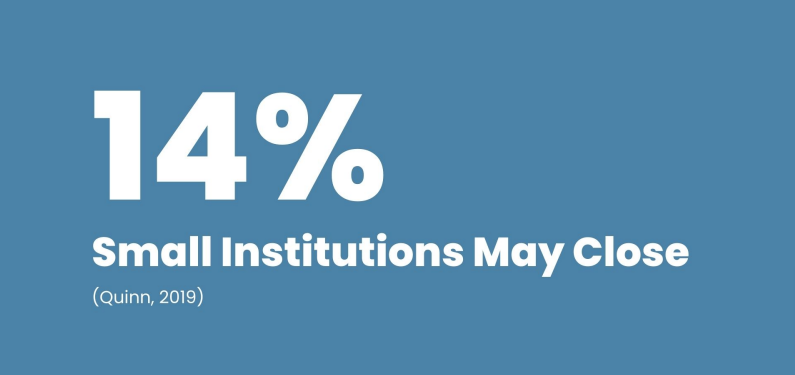
“Historically, universities have just gone out and recruited more students. And the reality is they can’t do that anymore,” Dr. Phillips says. “So now institutions are having to balance budgets, make changes that make the university flat from a fiscal perspective.”
Those that don’t adapt are at serious risk of bankruptcy.
4. Marketing Strategies To Prepare for the Enrollment Cliff
So, the enrollment cliff is here, which has severe ramifications for higher education institutions.
However, marketers are well placed to prepare for and mitigate the likely impact.
To understand the most effective strategies, Dr. Phillips visited with 15 chief marketing officers at regional public universities, as she believed these institutions had the most to gain or lose from the enrollment cliff (although the tips and tactics she identified apply to any institution).
She examined their marketing plans, budgets, brand pillars, and messaging guidelines. She analyzed the data to devise four key strategies that higher education social media leaders can use to become the change agents their campuses desperately need.
Strategy #1: Build Collaboration With Campus Partners

Social media is a collaborative environment. But who, exactly, should you be collaborating with?
Dr. Phillips recommends focusing on four key areas:
- Admissions: “They need great messaging, they need great email content, they need great pictures and video. Guess what we have? Great pictures, video, and messages.”
- Advancement: “They’re looking for success stories of our students. They’re looking for what faculty are up to. They’re looking for those great accolades, and those are all things that our office has.”
- Athletics: “Athletics is a front door to so many institutions, so if you have a great athletic team, that’s a great place to start building collaboration.”
- Academics: “I give you a little bit of caution here because every department on campus thinks their academic programs are the most important. However, if you have someone in a leadership role in academics that can help set that priority, it’ll make working with academics so much better, helping you highlight the students, the successes of the programs, and really tell that story in a meaningful way.”
Your goal here is to make it as easy as possible for other teams to get involved in marketing.
That could involve building a content team comprising people from admissions, advancement, athletics, and some of your academic units. “Instead of just guessing what content is relevant to them, work with them and develop that content plan,” Dr. Phillips says.
Another method she recommends is to run lunch-and-learn sessions and share ideas with other teams, helping them understand what effective content looks like.
Dr. Phillips also advises social media marketers to develop brand templates and digital assets that other departments can use to share their stories.

Finally, she suggests holding monthly content planning meetings with key partners, where you sit down with them one-on-one and work through their content needs.
Strategy #2: Double Down on Branding
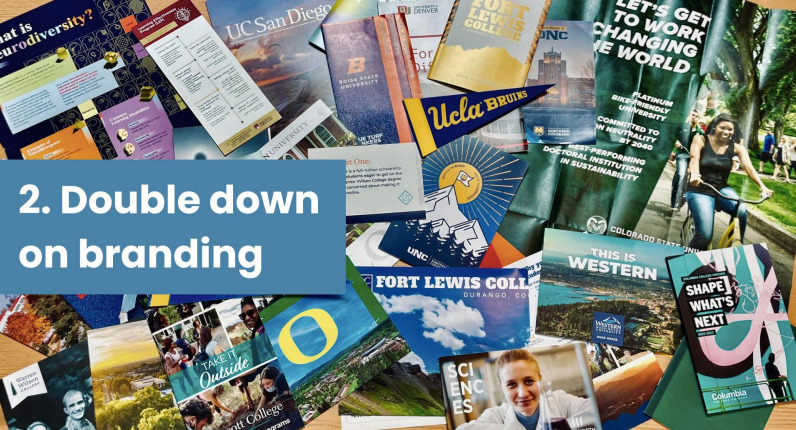
With so many priorities on your plate, it’s easy to overlook the importance of quality branding. But Dr. Phillips insists it should be a key focus.
“We are competing against everything that is out there on social media,” she explains. “That means it’s really important for things to look and sound consistent.”
Of course, the siloed nature of higher education institutions can make consistency hard to achieve.
You might have one team typing in all caps and using exclamation points, one just reposting blanket flyers that don’t get any engagement, and one that tries hard but uses all the wrong names and logos.
While prospective students might not consciously notice all those differences, Dr. Phillips is confident they affect their impressions of your institution.
Apple is a fantastic case study into the importance and effectiveness of branding.
For about twenty years, Apple proclaimed itself innovative, forward-thinking, and at the cutting edge of technology. This message became ingrained in our perceptions of the company.
Dr. Phillips tried to do the same thing at UA Little Rock. Take a look at their brand pillars:
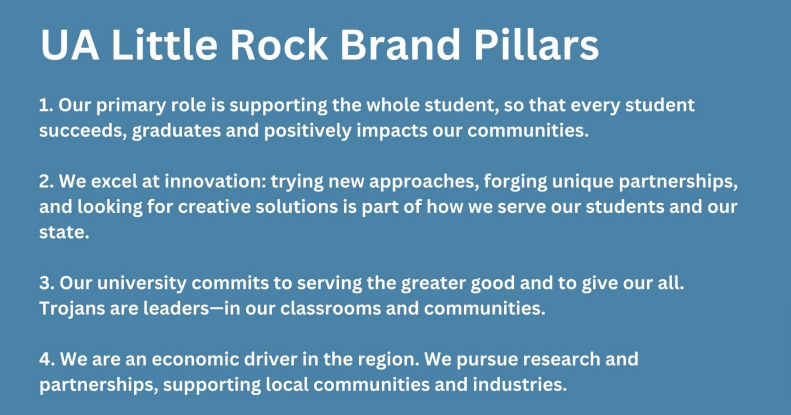
“We want every message on our accounts across campus to tie into these branding pillars and messages with the idea that, over time, that’s what people are going to start to think,” she explains.
If you don’t have brand pillars, don’t worry; developing them is pretty simple.
When Dr. Phillips started at UA Little Rock, she met with many people across campus. At the end of those sessions, she asked them to write down what the university meant to them.
She took those notes, pinned them on her whiteboard, developed them into broad themes, and started finessing them with her team.
Next, she took those concepts to other stakeholders throughout the institution and ran social media training on creating content that aligned with their new core messages.
“Then we went one step further and tried to provide training on images,” Dr. Phillips adds. “What did it look like to have an image that supported the ideas we were sharing?”
Strategy #3: Personalize Everything You Possibly Can

Today, consumers are used to seeing content that perfectly aligns with their viewing, reading, or listening preferences. Dr. Phillips warns that if higher ed marketers don’t try to do the same, they miss a big opportunity.
Here’s how to do it:
Leverage Social Listening
Social listening tools help you understand what people say about your institution — even if you’re not tagged in the conversation. Sharing content around those recurring talking points is one of the most effective ways to build a more curated social media presence.
Invite People To Share Their Journeys
Social media marketers can enlist students and campus members to create highly engaging content in various ways.
For instance, Dr. Phillips notes that UA Little Rock runs a contest several times a year for students to become the next “face” of the institution.
“We capture those students’ stories — what they’re interested in, what they’re studying, but also the services they’ve used,” she says. “It gives us great opportunities when we’re looking to capture imagery on campus.”
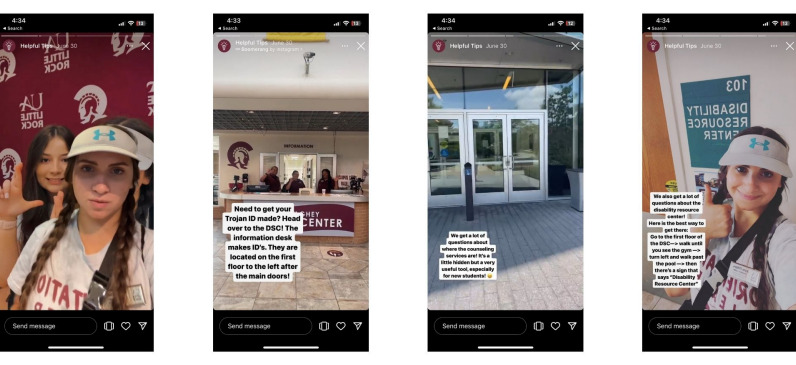
Check Your DMs
You must continually monitor your social messages and respond to current and prospective students’ questions.
Or you can go one step further and hold public ask me anything sessions, which have become a core strategy at UA Little Rock.
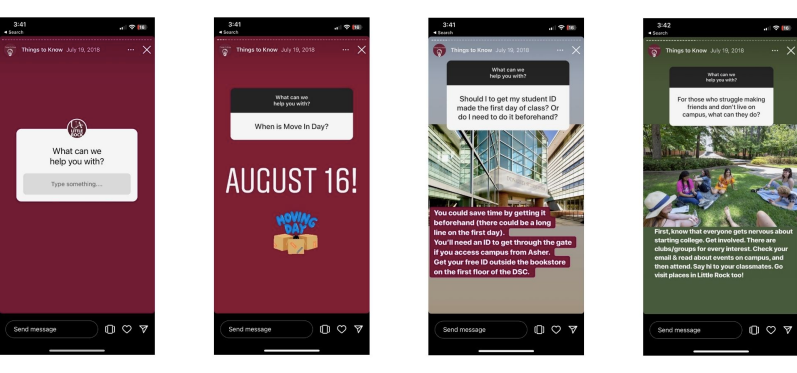
“It’s become such an important part of our visit days as we lead up to moving-in day,” Dr. Phillips says. “We continue to do them again and again because we know it matters to those students.”
Strategy #4: Show the Value Social Media Brings

Increasingly, higher education marketing leaders report directly to presidents and chancellors, giving social media marketers greater opportunities to demonstrate their impact.
“The more that you can show the value social brings, that’s going to really help marketing leaders highlight the value that the entire office and division brings,” Dr. Phillips explains.
Here are her tips for demonstrating the critical role played by social media teams:
Schedule Time With Leadership
The first step is to book time with your institution’s marketing leader to discuss your:
- Vision
- Social strategy
- Brand messages
- Trending topics
In these sessions, there’s also an opportunity to share areas in which you need support, whether that’s more resources or a specific tool or piece of equipment.
“You may not get those things, but presenting your vision is really important for leadership to help understand the importance of social,” says Dr. Phillips.
Share Social Media Wins
Don’t be shy about sharing your team’s biggest success stories.
For instance, at one of Dr. Phillips’ previous institutions, a graduating student got a surprise visit from his serviceman brother right as he walked across the stage.
Unsurprisingly, the footage went viral and even appeared on the Today show, so Dr. Phillips rounded up all the outlets that reported the story and shared them with her leadership team.
“It was really fun to get to send that email and say, ‘Hey, that piece of content that we had, here are some places that you may not have seen it,’” she says.
Be the Canary in the Mine Shaft
Unfortunately, social media marketers don’t always have good news to share. You’re also like the canary in the coal mine for your institution, highlighting potential issues before they escalate.
“We have to be the person that raises our hand and says, ‘Hey, I’m seeing a lot of grumbling about this thing that’s happening,’ or ‘Hey, we’ve got a problem over here. This is something that students are saying a lot about,’” Dr. Phillips points out.
While this might not be the most fun part of the job, it’s another clear demonstration of social media’s value.
Frame Your Reporting
Social media reports are full of data. But while those figures might be super clear to you, your leadership team might have different opinions.
“We don’t ever want somebody to just look at a bunch of numbers and not understand and then maybe make a wrong assumption,” Dr. Phillips explains. “I think it’s so much more important that we provide the context, provide the framing, and let the metrics tell the story that you think is most important.”
Sure, that takes more work than just sharing a spreadsheet full of digits, but it helps to highlight your vision and the results you’re generating.
Next Steps
Dr. Phillips believes in leaving conferences, workshops, and webinars with actionable takeaways.
To that end, she suggests three immediate steps you can take to navigate the enrollment cliff:
- Find a way to personalize a message on social
- Reach out to one department to start discussing opportunities for collaboration
- Start working on your branding efforts to increase consistency
Do you want more strategies, tips, and insights for higher ed social media marketers? Look out for our next social media conference!
Featured image by Freepik.



